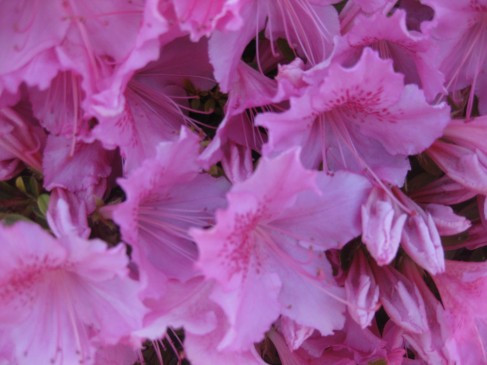Rhododendron • Rhododendron / Azalea • シャクナゲ / ツツジ • 石楠花 / 躑躅 • shakunage / tsutsuji
There are 2 clumps of them, in two shades of pink corolla, sitting on the bend of the E path, across from willow tree. The plant book states that they are about 3′ tall, and they are kept and pruned about that hight. While searching internet for a write up about it I came upon term ‘Dawn Pericat Hybrid Azalea’, so I searched the term, as well; it turns out that like kurume hybrids, pericat is another type of hybrids – there is a link below to an article from North Carolina State University; it covers azaleas growing there, but it gives a good explanation on different types of hybrid azaleas. I had some problems to figure out if our is ‘brooks’, ‘pericat’ or ‘kaempferi’ dawn azalea, but after looking at the pics and description, I think it’s ‘pericat’ – please correct, if wrong, but it may be also a cross between them: seems it has been tried.

SJG • 5/6/12 – Rhododendron ‘Dawn’, azalea – on the bend of the E path, area L – the two pink clumps (past the half of the red ‘Bouquet Rose’ azalea in the foreground)
From the Backyard Gardener: The Pericat azaleas were originally developed as greenhouse forcing plants, but they are as hardy as the Kurume azaleas, to 5 and 10 degrees F. Not to be confused with a R. kaempferi hybrid or a Brooks hybrid, both also named ‘Dawn.’ Dense, spreading, evergreen shrub with small, 1 to 2 inch long, elliptic, glossy, dark green leaves. Flowers are borne from early to midsping in profuse, showy trusses of 1 to 3 per cluster, which literally cover the plant. Best adapted to partial sun.
Types of azaleas from M. A. “KIM” POWELL, Extension Horticultural Specialist at North Carolina State University: Pericat Hybrids – The Pericat hybrids were introduced as greenhouse forcing azaleas in 1931. Some are as hardy as the Kurume but most are rather tender. (They were crosses between the Kurume and Belgian Indican Azaleas.) For landscape purposes they should be used only in southern areas of N.C.


